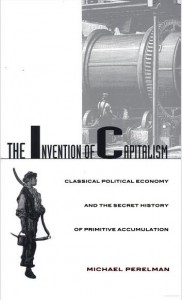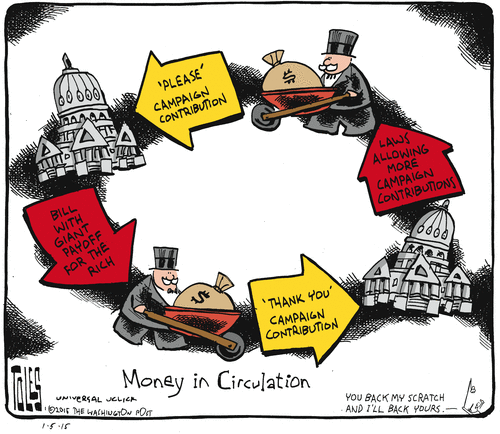by Paul Rosenberg

The christian wingnus's obsessive hatred of Darwin is a wonder to
behold, but it could someday be rivaled by the hatred of someone you’ve
probably never even heard of. Darwin earned their hatred because he
explained the evolution of life in a way that doesn’t require the hand
of dog. Darwin didn’t exclude dog, of course, though many creationists
seem incapable of grasping this point. But he didn’t require dog,
either, and that was enough to drive some people mad.
Darwin also
didn’t have anything to say about how life got started in the first
place — which still leaves a mighty big role for dog to play, for those
who are so inclined. But that could be about to change, and things could
get a whole lot worse for creationists because of Jeremy England, a
young
MIT professor who’s
proposed a theory, based in thermodynamics, showing that the emergence
of life was not accidental, but necessary. “[U]nder certain conditions,
matter inexorably acquires the key physical attribute associated with
life,” he was quoted as saying in an
article in Quanta magazine early
in 2014, that’s since been republished by Scientific American and, more
recently, by Business Insider. In essence, he’s saying, life itself
evolved out of simpler non-living systems.
The notion of an
evolutionary process broader than life itself is not entirely new.
Indeed, there’s evidence, recounted by Eric Havelock in “
The Liberal Temper in Greek Politics,”
that it was held by the pre-Socratic natural philosophers, who also
first gave us the concept of the atom, among many other things. But
unlike them or other earlier precursors, England has a specific,
unifying, testable evolutionary mechanism in mind.
Quanta fleshed things out a bit more like this:
From
the standpoint of physics, there is one essential difference between
living things and inanimate clumps of carbon atoms: The former tend to
be much better at capturing energy from their environment and
dissipating that energy as heat. Jeremy England,
a 31-year-old assistant professor at the Massachusetts Institute of
Technology, has derived a mathematical formula that he believes explains
this capacity. The formula, based on established physics, indicates
that when a group of atoms is driven by an external source of energy
(like the sun or chemical fuel) and surrounded by a heat bath (like the
ocean or atmosphere), it will often gradually restructure itself in
order to dissipate increasingly more energy. This could mean that under
certain conditions, matter inexorably acquires the key physical
attribute associated with life.
It doesn’t mean we
should expect life everywhere in the universe — lack of a decent
atmosphere or being too far from the sun still makes most of our solar
system inhospitable for life with or without England’s perspective. But
it does mean that “under certain conditions” where life is
possible — as it is here on Earth, obviously — it is also quite
probable, if not, ultimately,
inevitable.
Indeed, life on Earth could well have developed multiple times
independently of each other, or all at once, or both. The first truly
living organism could have had hundreds, perhaps thousands of siblings,
all born not from a single physical parent, but from a physical system,
literally pregnant with the possibility of producing life. And similar
multiple births of life could have happened repeatedly at different
points in time.
That also means that Earth-like planets circling
other suns would have a much higher likelihood of carrying life as well.
We’re fortunate to have substantial oceans as well as an atmosphere —
the heat baths referred to above — but England’s theory suggests we
could get life with just one of them — and even with much smaller
versions, given enough time. Giordano Bruno, who was burnt at the stake
for heresy in 1600, was perhaps the first to take Copernicanism to its
logical extension, speculating that stars were other suns, circled by
other worlds, populated by beings like ourselves. His extreme minority
view in his own time now looks better than ever, thanks to England.
If
England’s theory works out, it will obviously be an epochal scientific
advance. But on a lighter note, it will also be a fitting rebuke to
pseudo-scientific creationists, who have long mistakenly claimed that
thermodynamics disproves evolution (
here,
for example), the exact opposite of what England’s work is designed to
show — that thermodynamics drives evolution, starting even before life
itself first appears, with a physics-based logic that applies equally to
living and non-living matter.
Most important in this regard is the
Second Law of Thermodynamics, which states that in any
closed process, there is an increase in the total
entropy (roughly
speaking, a measure of disorder). The increase in disorder is the
opposite of increasing order due to evolution, the creationists reason,
ergo —
a contradiction! Overlooking the crucial word “closed,”
of course. There are various equivalent ways of stating the law, one of
which is that energy cannot pass from a cooler to a warmer body without
extra work being done. Legendary science and science fiction writer
Isaac Asimov put it like this: “You can’t win. You can’t break even. You
can’t get out of the game.” Although creationists have long mistakenly
believed that evolution is a violation of the Second Law, actual
scientists have not. For example, physicist Stephen G. Brush, writing
for The American Physical Society in 2000, in “
Creationism Versus Physical Science,”
noted: “As Ludwig Boltzmann noted more than a century ago,
thermodynamics correctly interpreted does not just allow Darwinian
evolution, it favors it.”
A simple explanation of this comes from
a document in the
thermodynamics FAQ subsection
of TalkOrigins Archive (the first and foremost online repository of
reliable information on the creation/evolution controversy), which in
part explains:
Creationists thus misinterpret the 2nd law to say that things invariably progress from order to disorder.
However,
they neglect the fact that life is not a closed system. The sun
provides more than enough energy to drive things. If a mature tomato
plant can have more usable energy than the seed it grew from, why should
anyone expect that the next generation of tomatoes can’t have more
usable energy still?
That passage goes right to the
heart of the matter. Evolution is no more a violation of the Second Law
than life itself is. A more extensive, lighthearted, non-technical
treatment of the creationist’s misunderstanding and what’s really going
on can be found
here.
The driving flow of energy — whether from the sun or some other source — can give rise to what are known as
dissipative structures,
which are self-organized by the process of dissipating the energy that
flows through them. Russian-born Belgian physical chemist
Ilya Prigogine won
the 1977 Nobel Prize in Chemistry for his work developing the concept.
All living things are dissipative structures, as are many non-living
things as well — cyclones, hurricanes and tornados, for example. Without
explicitly using the term “dissipative structures,” the passage above
went on to invoke them thus:
Snowflakes, sand dunes,
tornadoes, stalactites, graded river beds, and lightning are just a few
examples of order coming from disorder in nature; none require an
intelligent program to achieve that order. In any nontrivial system with
lots of energy flowing through it, you are almost certain to find order
arising somewhere in the system. If order from disorder is supposed to
violate the 2nd law of thermodynamics, why is it ubiquitous in nature?
In
a very real sense, Prigogine’s work laid the foundations for what
England is doing today, which is why it might be overstated to credit
England with
originating this theory, as several commentators at Quanta pointed out, noting other progenitors as well (
here,
here and
here,
among others). But already England appears to have assembled a
collection of analytical tools, along with a sophisticated
multidisciplinary theoretical approach, which promises to do much more
than simply propound a theory, but to generate a whole new research
agenda giving detailed meaning to that theoretical conjecture. And that
research agenda is already starting to produce results. (See his
research group home page for
more.) It’s the development of this sort of detailed body of specific
mutually interrelated results that will distinguish England’s
articulation of his theory from other earlier formulations that have not
yet been translated into successful theory-testing research agendas.
Above
all, as described on the home page mentioned above, England is involved
in knitting together the understanding of life and various stages of
life-like processes combining the perspectives of biology and physics:
Living
things are good at collecting information about their surroundings, and
at putting that information to use through the ways they interact with
their environment so as to survive and replicate themselves. Thus,
talking about biology inevitably leads to talking about decision,
purpose, and function.
At the same time, living things are also
made of atoms that, in and of themselves, have no particular function.
Rather, molecules and the atoms from which they are built exhibit
well-defined physical properties having to do with how they bounce off
of, stick to, and combine with each other across space and over time.
Making
sense of life at the molecular level is all about building a bridge
between these two different ways of looking at the world.
If that sounds intriguing, you might enjoy this
hour-long presentation of his work (with splashes of local Swedish color) — especially (but not only) if you’re a science nerd.
Whether
or not England’s theory proves out in the end, he’s already doing quite
a lot to build that bridge between worldviews and inspire others to
make similar efforts. Science is not just about making new discoveries,
but about seeing the world in new ways — which then makes new
discoveries almost inevitable. And England has already succeeded in
that. As the Quanta article explained:
England’s
theoretical results are generally considered valid. It is his
interpretation — that his formula represents the driving force behind a
class of phenomena in nature that includes life — that remains unproven.
But already, there are ideas about how to test that interpretation in
the lab.
“He’s
trying something radically different,” said Mara Prentiss, a professor
of physics at Harvard who is contemplating such an experiment after
learning about England’s work. “As an organizing lens, I think he has a
fabulous idea. Right or wrong, it’s going to be very much worth the
investigation.”
Creationists often cast themselves as
humble servants of dog, and paint scientists as arrogant, know-it-all
rebels against him. But, unsurprisingly, they’ve got it all backwards,
once again. England’s work reminds us that it’s scientists’ willingness
to admit our own ignorance and confront it head on — rather than
papering over it — that unlocks the great storehouse of wonders we live
in and gives us our most challenging, satisfying quests.









 One thing that the
One thing that the  “The brutal acts associated with the process of stripping the
majority of the people of the means of producing for themselves might
seem far removed from the laissez-faire reputation of classical
political economy,” writes Perelman. “In reality, the dispossession of
the majority of small-scale producers and the construction of
laissez-faire are closely connected, so much so that Marx, or at least
his translators, labeled this expropriation of the masses as ‘‘
“The brutal acts associated with the process of stripping the
majority of the people of the means of producing for themselves might
seem far removed from the laissez-faire reputation of classical
political economy,” writes Perelman. “In reality, the dispossession of
the majority of small-scale producers and the construction of
laissez-faire are closely connected, so much so that Marx, or at least
his translators, labeled this expropriation of the masses as ‘‘















